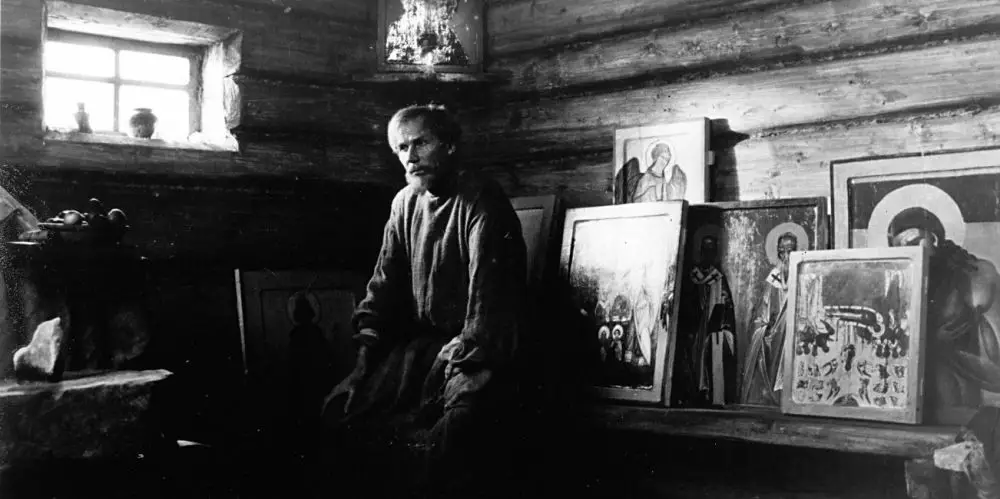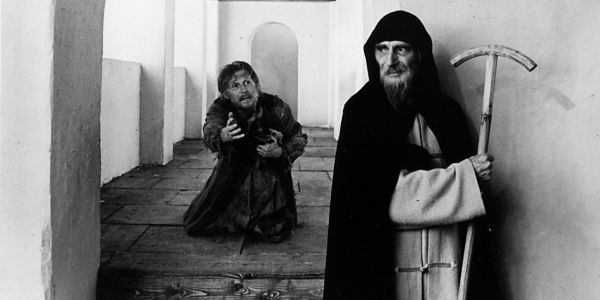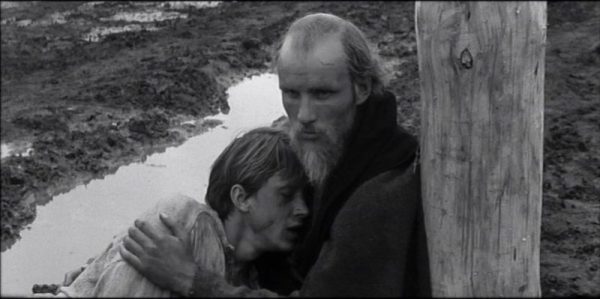Sculptures in Time Pt. II: Tarkovsky’s ANDREI RUBLEV

Stephen Borunda is an educator and filmmaker currently located in…
For Russian director Andrei Tarkovsky, the artist was inextricably joined to his society, both its benefits and its ills. Tarkovsky defined these colloquies between society and an individual artist as “dialectics of personality.” In other words, individual development was indefinably caught-up within personal and distant interactions with a society.
In an exploration of these aforementioned dialectics, Tarkovsky’s 1966 epic Andrei Rublev, or The Passion According to Andrei, provides a semi-historical account of esteemed 15th-century Russian painter, Andrei Rublev (played wonderfully by Tarkovsky’s favorite actor Anatoly Solonitsyn). Divided into chapters, the film balances its cynosures between Rublev himself and his virulent society in order to explore how Rublev the man became Rublev the artist.
An Artist and His Society
At the impetus of the film, Rublev is depicted as a talented painter but “lacking insight,” according to his jealous friend Kirill. Rublev’s original artistic mentor is his fellow monk Daniil Chorny; but Rublev later gains apprenticeship under renowned painter: Theophanes the Greek. However, Rublev is unable to truly focus his efforts. His time for reflection on transcendental matters via his artistic work – in his monastery or during his paid commissions – is limited due to the chaotic society in which he lives.

The Russian landscape is marred by turmoil originating from a variety of sources. Political feuds, natural disasters, violent idolaters, foreign invaders, and jealousy from friends fill Rublev’s Russia. Even within his professional work, Rublev is discontent because of the disdain he has for the artistic orders put forth from the Russian gentry. Compelled by Russia’s wealthy to paint the death and destruction of the eschaton, Rublev simply wants to paint the beautiful and the inspiring for his people.
During a debate with Theophanes in the aftermath of a Tatar-led raid early on in the film, Rublev demonstrates an impressive ability to realize that the necessity of the suffering for human progress. Rublev recalls the torture Jesus faced before and during his crucifixion and the painter states, “Maybe those who crucified [Jesus] loved him because they helped in this divine plan.”
Ironically, subsequent to a later Tatar invasion aided by a Russian prince, Rublev is forced to kill a man to defend Durochka, a holy fool without the ability to speak. Rublev is disgusted with himself and how his Russia has been torn asunder. He takes a vow of silence and swears to never paint again. Rublev is unable to reconcile his own personal sufferings with his beliefs in the importance of the affliction Jesus faced for the salvation of humanity.
Our Role in the Body
For the remainder of the film, Rublev lives out his Jobean tale of woe without so much as a whisper. His friends depart from him; Daniil is perhaps dead and Durochka departs for a life with the Tatars. Paradoxical to his earlier actions and words that showed envy of Rublev, Kirill does return and pleads with Andrei to embrace his role and potential as an artist. However, Rublev’s attention turns towards the young bell caster named Boriska (the lead actor from Ivan’s Childhood, Nikolai Burlyayev).
Boriska is an ambitious young man who hears that the Grand Prince desires a beautiful bell to be built. Boriska then convinces the representatives of the Grand Prince that only he knows the true secret to casting bells. Utilizing instinct, luck, and the observations of his father’s work as a bell caster, Boriska is able to successfully create a beautiful and functioning bell.

Upon the completion of the bell, Boriska collapses in exhaustion. The Grand Prince would have executed Boriska had he failed. Rublev has observed much of Boriska’s work and determination in tacit amazement. Boriska never falters – despite the antagonistic governmental forces that metaphorically surround him. Rublev encourages Boriska to work with him; Rublev will paint for the people and Boriska will create bells. The film concludes with slow tracking shots of Rublev’s paintings that express appeals to fraternity and love such as his “Trinity” painting.
Rublev’s epiphany is perhaps comparable to the one made by the warrior Arjuna in the Hindu holy book, the Bhagavad Gita. Due to Krishna’s intervention, Arjuna realizes that he has a purpose in the universe assigned by the divine that must be fulfilled. However, Rublev, like Arjuna, only reaches this moment of clarity about himself as an artist despite and because of the decrepit and ferocious society within which he lived. Both the beautiful and frightening interactions between Rublev and his society transform the painter intro a true artist and provide him with the insight his friend Kirill noted was lacking.
A Reflection of Reality: A Terrifying Mirror
Any cinematic exegesis of Andrei Rublev would be incomplete without a brief discussion of how the challenges faced by Andrei Rublev in the film were also met by the film’s auteur. Just as the famous painter struggled due to the oppressions indicative of his time, so too was Tarkovsky intellectually stifled as a result of spiritual pursuits within cinema.
Tarkovsky’s cinematic work on spirituality and an oppressive society were not well received by the Communist Party in the Soviet Union. The film, completed in 1966, did not receive a release until 1969, when a French company secretly acquired the rights to the film. The 205-minute edition of the film was not released until the 1990s and the grainy quality of the film leaves something to be desired.
Yet, we might certainly surmise that just as Rublev was made into an artistic genius due the “dialectics of personality” between himself and his Russian society. So too was Tarkovsky allowed to become his truest artistic self as a consequence of Soviet interference. After Andrei Rublev, Tarkovsky’s films took even more of a metaphysical and poetic bent that has not since been truly emulated.
It’s amazing how this film, on the narrative, production, and aesthetic levels, continues to whisper that, beneath the muck caused by an individual’s interactions with social pain and suffering, lies a higher truth and calling just waiting to be discovered.
Apart from the Bhagavad Gita, what other stories about the sculpting power of pain and suffering remind you of Andrei Rublev? How do you think the troubles Tarkovsky faced from the Soviet Union influenced his future work? What moves you about Andrei Rublev?
Does content like this matter to you?
Become a Member and support film journalism. Unlock access to all of Film Inquiry`s great articles. Join a community of like-minded readers who are passionate about cinema - get access to our private members Network, give back to independent filmmakers, and more.
Stephen Borunda is an educator and filmmaker currently located in Baltimore, Maryland. He completed his undergraduate and graduate education at the Johns Hopkins University. Stephen loves metaphysical films, photography, inspirational poetry, philosophy with political utility, and bashing his head in as a rugby player. Hopefully, his writing doesn't suffer too much as a result of this trauma.













